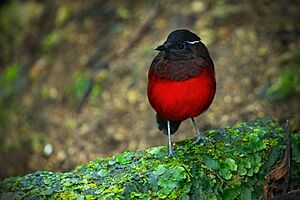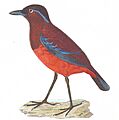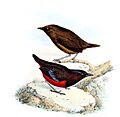Graceful pitta facts for kids
Quick facts for kids Graceful pitta |
|
|---|---|
 |
|
| Conservation status | |
| Scientific classification | |
| Genus: |
Erythropitta
|
| Species: |
venusta
|
| Synonyms | |
|
|
The graceful pitta (Erythropitta venusta), sometimes alternatively known as the black-crowned pitta (although this term is more regularly applied to E. ussheri), is a species of bird in the family Pittidae. It occurs in Sumatra in Indonesia, where its natural habitat is subtropical or tropical moist montane forests. It is threatened by habitat loss.
Taxonomy
The graceful pitta was formally described in 1836 by the German naturalist Salomon Müller under the binomial name Pitta venusta. His specimens had been collected in western Sumatra. The specific epithet is from Latin venustus meaning "beautiful" or "lovely". The graceful pitta is now one of 15 species placed in the genus Erythropitta that was introduced in 1854 by Charles Lucien Bonaparte. The species is monotypic: no subspecies are recognised.
Description
The graceful pitta is a petite bird that measures approximately 18 cm (7.1 in) in length. Its black coloring is enhanced with reddish undertones, and the bottom of its wings have vivid blue stripes running down them. The lower breast and abdomen are a dull crimson. The upper chest is dark brown with a purple hue. The legs can appear to be either a purple-blue or a pale blue, and its iris is a dark brown color. The bill is black. The extended tail has reddish-black hues. Males and females are similar in appearance. Juveniles have an all dark brown exterior with less color variation throughout the body. They also have pinkish-grey feet, a red tipped bill, and grayish colored irises.
The call has been described as a high pitched train whistle which remains at a consistent pitch.
Distribution and habitat
The graceful pitta is a native of the Indonesian Sumatra's highlands. The Sumatra highlands consist of thick tropical forest with various species of plants, animals, and insects. It inhabits dense, moist woods with a thick understory of plants. But the habitat is decreasing rapidly due to deforestation. This has increased due to the demand for palm oil with Indonesia being the largest producer of it.
Behaviour
The graceful pitta flies close to the ground. Primarily in residential levels through the trees.
Breeding
Only one nesting has been recorded for graceful pittas which took place in May. But according to research, breeding can take place from May to July, and possibly as early as from February to October. The birds construct their nests that typically are placed around 60 cm above the ground, using materials such as dead leaves, bamboo leaves, fine roots, degraded fibers, and moss. The graceful pitta typically can produce two to three eggs every breeding cycle. Each of the eggs has a distinctive look with a dull white tone and dark brown and gray lilac spots.
Status
The graceful pitta is very rare and is at risk and vulnerable. Although it has been legally protected from hunting since 1931, they still have a primary threat of deforestation to its habitat in Indonesia. This causes their population to steadily decrease as more areas become less occupant/available.
Gallery




